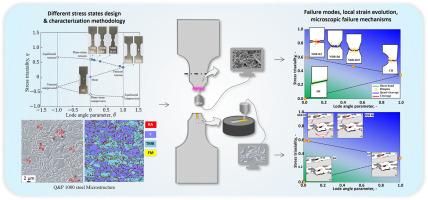Failure mechanisms in quenching and partitioning (Q&P) steel under varying stress states
IF 14.3
1区 材料科学
Q1 MATERIALS SCIENCE, MULTIDISCIPLINARY
引用次数: 0
Abstract
Quenching and partitioning (Q&P) steels represent a key advancement in third-generation advanced high-strength steels (AHSS), offering an exceptional balance between strength and ductility due to their complex multiphase microstructures. However, their application in crash-critical and formability-sensitive components remains limited by an incomplete understanding of their fracture behavior under complex stress states. Therefore, this study aims to systematically investigate the failure mechanisms of Q&P 1000 steel across a wide range of stress states from shear to uniaxial and plane-strain tension using tensile specimens with different geometries. By combining macroscopic mechanical testing with detailed microstructural characterization via scanning electron microscopy (SEM) and electron backscatter diffraction (EBSD), we reveal a transition from ductile fracture, governed by void nucleation and coalescence, to cleavage-dominated fracture under increasing triaxiality. Remarkably, transgranular cleavage fracture features were observed for the first time in Q&P steels even after substantial plastic deformation, which confirms it to be also a failure mechanism of ductile fracture in addition to brittle fracture. Two major damage mechanisms responsible for the failure mode transition were revealed: (i) phase boundary debonding and (ii) martensite cleavage fracture. A stress-based cleavage fracture criterion with a critical stress triaxiality, regulated by the cleavage fracture stress and strain hardening behavior, can well explain and quantify this transition behavior. These results provide new insights into stress-state-dependent failure in Q&P steels and offer guidance for their safe and optimized application in forming and crash-relevant components.

不同应力状态下淬火和分配(Q&P)钢的失效机制
淬火和分区(Q&;P)钢代表了第三代先进高强度钢(AHSS)的关键进步,由于其复杂的多相显微组织,在强度和延展性之间提供了卓越的平衡。然而,由于对其在复杂应力状态下的断裂行为的不完全理解,它们在碰撞临界和成形敏感部件中的应用仍然受到限制。因此,本研究旨在系统地研究Q&; p1000钢在各种应力状态下的破坏机制,从剪切到单轴和平面应变拉伸,使用不同几何形状的拉伸试样。通过宏观力学测试与扫描电镜(SEM)和电子背散射衍射(EBSD)详细的微观结构表征相结合,我们揭示了在三轴性增加的情况下,由孔洞成核和聚结控制的韧性断裂向解理为主的断裂转变。值得注意的是,在Q&;P钢中,即使经过大量塑性变形,也首次观察到穿晶解理断裂特征,这证实了它也是脆性断裂之外的一种韧性断裂失效机制。揭示了导致失效模式转变的两种主要损伤机制:(i)相边界脱粘和(ii)马氏体解理断裂。基于应力的解理断裂准则具有临界应力三轴性,由解理断裂应力和应变硬化行为调节,可以很好地解释和量化这种转变行为。这些结果为Q&;P钢的应力状态相关失效提供了新的见解,并为其在成形和碰撞相关部件中的安全和优化应用提供了指导。
本文章由计算机程序翻译,如有差异,请以英文原文为准。
求助全文
约1分钟内获得全文
求助全文
来源期刊

Journal of Materials Science & Technology
工程技术-材料科学:综合
CiteScore
20.00
自引率
11.00%
发文量
995
审稿时长
13 days
期刊介绍:
Journal of Materials Science & Technology strives to promote global collaboration in the field of materials science and technology. It primarily publishes original research papers, invited review articles, letters, research notes, and summaries of scientific achievements. The journal covers a wide range of materials science and technology topics, including metallic materials, inorganic nonmetallic materials, and composite materials.
 求助内容:
求助内容: 应助结果提醒方式:
应助结果提醒方式:


